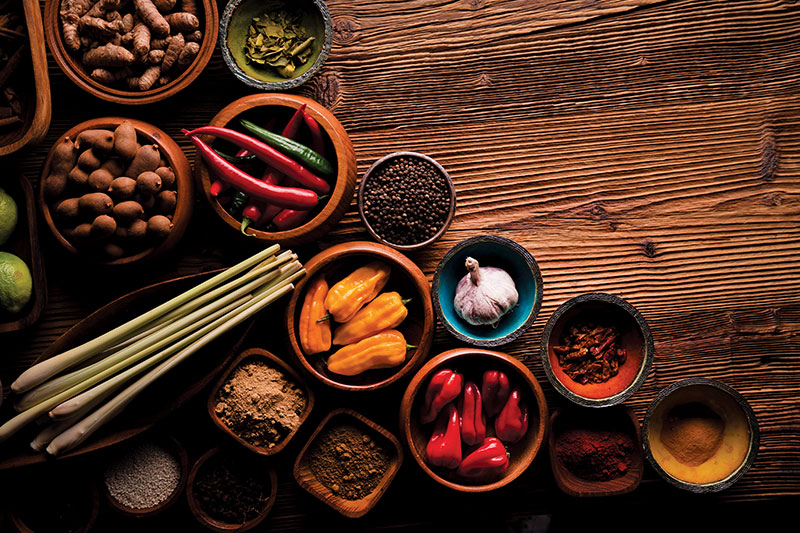
Siam’s Flavourful Secrets
How Thai food adapted foreign flavours to create a unique cuisine loved around the world
Words Pinanong Panchuen & Anutra Ungsuprasert
Photos Shutterstock
The Essence of Thai Cuisine
Thai cuisine is celebrated worldwide for its tantalising blend of sweet, sour, salty and spicy flavours, with notes of umami creating a perfect harmony. At the heart of this tasty rhythm are the spices and herbs that define Thai cooking. These ingredients, deeply embedded in Thai culture, have bubbled over borders, enriching kitchens around the globe with their distinctive aromas and health benefits.
How did these bold flavours journey from bustling local markets to high-end restaurants and home kitchens worldwide? From fiery bird’s eye chillies to aromatic kaffir lime leaves, the global spread of Thai herbs and spices is a fascinating story of trade, tradition, and culinary evolution.
Beyond their role in cooking, these herbs and spices are also integral to traditional Thai remedies and holistic healing practices. Many Thai households rely on herbal infusions, balms, and natural tonics made from ingredients like lemongrass, turmeric, and ginger to treat common ailments and boost overall well-being. This deep-rooted connection between food and medicine further elevates the significance of Thai spices in daily life.
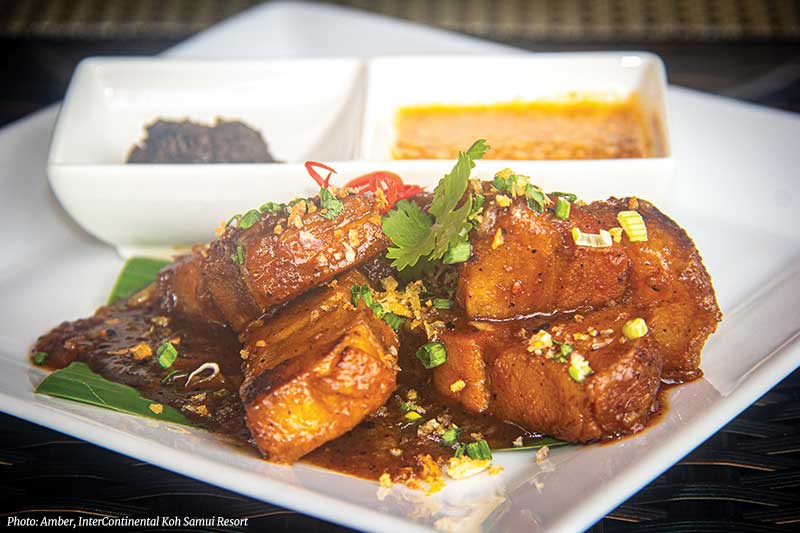
Thai cuisine’s ability to integrate these ingredients into both simple home-cooked meals and elevated gourmet experiences is exemplified by Amber at InterContinental Koh Samui Resort. Known for its refined approach to traditional Thai cooking, Amber presents a sophisticated version of Moo Kho Krathiam, a dish that pays homage to the delicate balance of Thai seasonings. The pork is slow-braised with garlic, white pepper, and hint of palm sugar, ensuring deep umami flavours that pair beautifully with a peppercorn dipping sauce. The careful layering of aromatics highlights the harmony that defines Thai cuisine, making Moo Kho Krathiam a comforting yet sophisticated dining experience. The dish is complemented by a side of jasmine rice, which absorbs the flavours of the rich sauce, and a fresh herbal salad to balance the richness with a burst of freshness.
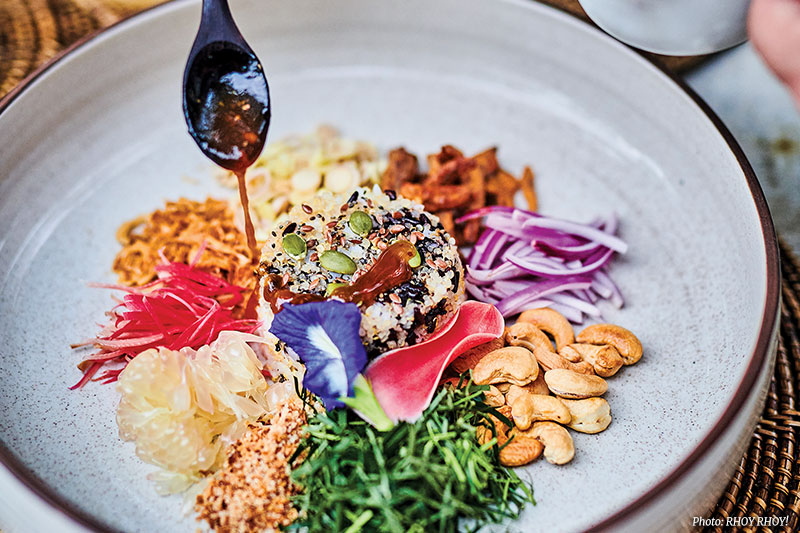
At RHOY RHOY! In Garrya Tongsai Bay Samui, Khao Yum Pak Tai is a vivid tapestry of flavours, embodying the artful spice play of Southern Thai cuisine. Each element – shredded herbs, crisp vegetables, toasted coconut, and fragrant rice tinted with butterfly pea – is balanced to culinary perfection. The soul of the dish lies in nam budu, a fermented fish sauce infused with lemongrass, kaffir lime leaves, and chillies, lending a deep, umami-laden complexity. This aromatic elixir binds the ingredients, transforming each bite into a medley of heat, tang, and earthiness. Unlike the fiery curries of the South, Khao Yum Pak Tai speaks in whispers of spice, where turmeric and galangal subtly brighten the ensemble.
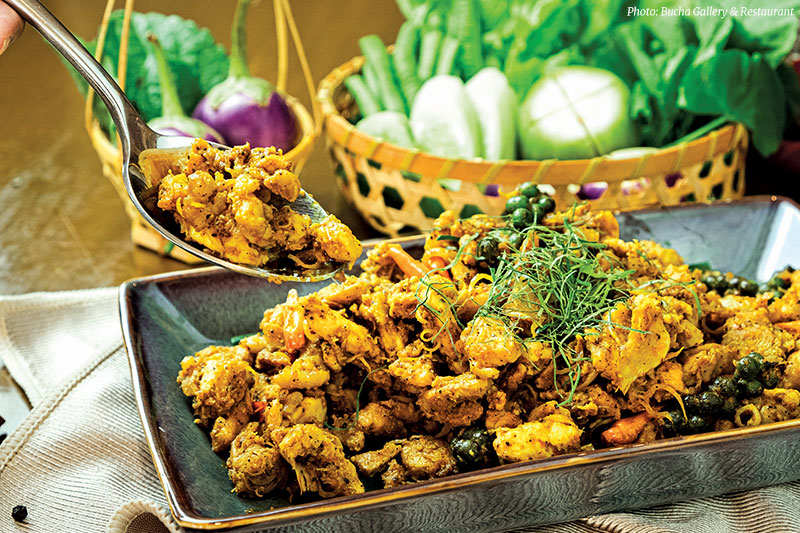
A History Rooted in Flavour
The ancient Thai proverb, “In the water, there are fish; in the fields, there is rice”, beautifully captures the nation’s natural abundance, where fertile lands and flowing waters sustain a cuisine traditionally based on rice and freshwater fish.
Early Thai cuisine was shaped by simple cooking methods – boiling, steaming, and grilling – since earthen cookware couldn’t withstand high heat. Fish, shrimp, and shellfish from rivers and canals were the primary protein sources, while pigs were raised and consumed, though not as commonly as fish. Cattle, on the other hand, were rarely eaten due to their role in agriculture and cultural beliefs.
During the Ayutthaya period (1351-1767), Thailand thrived as a hub of international trade, absorbing culinary influences from Persia, India, Portugal, China, and the Malay-Indonesian spice trade. These exchanges introduced new ingredients and techniques that shaped Thai cuisine. The Chinese brought stir-frying and deep-frying over high heat, while the Portuguese introduced chilli peppers, tomatoes, and egg-yolk-based desserts. Garlic and onions, already present in Thai cooking, became more widely used. Persian traders, particularly Sheikh Ahmad Qomi, contributed spice- rich dishes like Massaman curry, while Indian traders introduced cumin, coriander, and cardamom. Nutmeg and cloves, central to the Malay-Indonesian spice trade, also made their way into Thai curries, adding depth and complexity to local flavours.
Today, this evolution continues in restaurants like Bucha Gallery & Restaurant in Phuket, where Thai flavours are celebrated with an artistic and contemporary approach. One of their standout dishes, Khua Kling Gai, represents the bold flavours of Southern Thailand. This dry stir-fried chicken dish is packed with fresh turmeric, bird’s eye chillies, and kaffir lime leaves, creating an explosion of fragrance and heat. At Bucha, the dish is served with a side of jasmine rice and a cooling cucumber relish to counterbalance the intensity. The presentation, however, is anything but traditional – carefully plated with edible flowers and microgreens, the dish reflects the restaurant’s commitment to merging heritage with modern aesthetics. Bucha’s take on Thai cuisine exemplifies how historical influences have been expertly adapted into a dining experience that is as visually striking as it is flavourful.
However, what makes Thai cuisine trully unique is the way these foreign influences were adapted by local tastes and traditions. Rooted in the art of balancing flavours, Thai cooking relies on herbs to enhance fragrance while mellowing strong odours.
The fusion of imported spices with native ingredients – lemongrass, galangal, and basil – has fostered a vibrant culinary identity, where dishes seamlessly blend heat, tanginess, sweetness, and umami flavours.
The enduring popularity of Thai cuisine also stems from its adaptability. While it retains its signature flavour profiles, Thai food has evolved to cater to various dietary preferences, from milder spice levels for Western palates to vegetarian versions that replace fish sauce with soy-based alternatives. This versatility has helped Thai cuisine transcend cultural boundaries and maintain its global appeal.
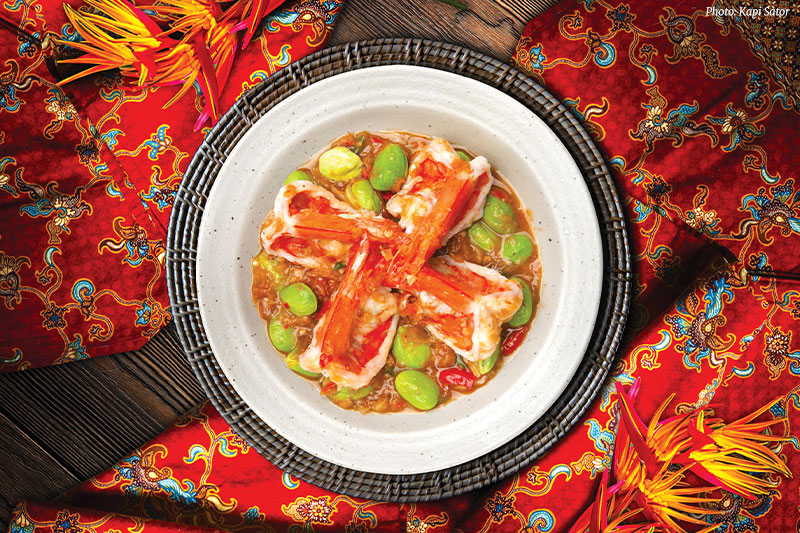
Packed with Health Benefits
Spices and herbs are the backbone of Thai cooking, from humble home kitchens and street food stalls to high-end restaurants.
Spices are aromatic, pungent, and sometimes fiery elements derived from various plant parts, including seeds, bark, roots, flowers, and leaves. Often dried and used whole or ground, examples include black pepper, bay leaves, cardamom, cloves, and cinnamon. Some spices, like coriander seeds, need to be roasted to release their full aroma. Beyond flavour, spices are also used to preserve food, enhance colour, and eliminate unwanted odours in meats and seafood.
Southern Thai cuisine is a bold interplay of these spices, often paired with robust ingredients that deliver both intensity and depth. At Kapi Sator in Koh Samui, this philosophy is at the heart of every dish. Named after kapi (fermented shrimp paste) and sator (stink beans), the restaurant stays true to its roots, highlighting these defining elements of the region’s cooking. A standout is Goong Phad Kapi Sator, a stir-fry of succulent prawns, aromatic shrimp paste, and sator beans. The umami-rich shrimp paste coats the prawns in a deep, savoury intensity, while the sator beans add a slightly bitter, nutty contrast. Bird’s-eye chillies, garlic, and shallots bring layers of heat and fragrance, with high-heat stir-frying creating a smoky caramelisation. Served with steamed jasmine rice, this dish is a perfect balance of spice, salt, and depth.
Herbs, on the other hand, are fresh or dried plants sometimes known for their medicinal properties, including chilli, ginger, galangal, lemongrass, kaffir lime leaves, and holy basil. Thai dishes often incorporate five or six different herbs, showcasing the expertise of Thai chefs in layering flavours and aromas to craft specialities that are bold yet perfectly balanced.
Thai spices and herbs are also renowned for their health benefits. Many have antibacterial properties, aid digestion, and boost immunity – making them ideal for Thailand’s tropical climate. It’s no wonder that Thai food is often described as the “most delicious medicine”.
With the rise of functional foods and natural health remedies, Thai spices are increasingly recognised for their medicinal potential beyond the kitchen. Turmeric’s curcumin content has gained global recognition for its anti-inflammatory benefits, while lemongrass is used in detoxifying teas. This intersection of food and wellness has positioned Thai spices at the forefront of the global health- conscious movement.
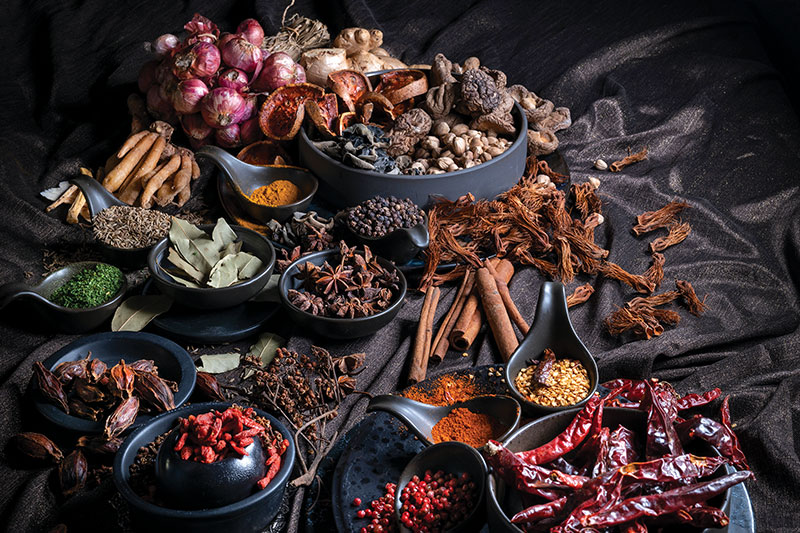
Say It Like a Local: A Quick Pronunciation Guide
- GAENG SOM PLA YOD MAPHRAO (แกงส้มปลายอดมะพร้าว, PRONOUNCED:
GÂENG SÔM PLAA YÔT MÁ-PRÂAO) - GOONG PHAD KAPI SATOR (กุ้งผัดกะปิสะตอ, PRONOUNCED: GÛNG PÀT GÀ-PÌ SÀ-DTO)
- KHAO SOI GAI (ข้าวซอยไก่, PRONOUNCED: KHÂAO SOI GÀI)
- KHAO YUM PAK TAI (ข้ายำปักษ์ใต้, PRONOUNCED: KHÂAO YAM PÀK TÂI)
- KHUA KLING GAI (คั่วกลิ้งไก่, PRONOUNCED: KHÛA GLÎNG GÀI)
- LAAB (ลาบ, PRONOUNCED: LÂAB)
- MASSAMAN (มัสมั่น, PRONOUNCED: MÁT-SÀ-MÀN)
- MOO KHO KRATHIAM (หมูโคกระเทียม, PRONOUNCED:
MǓU KHO GRÀ-THIAM) - PHANAENG (พะแนง, PRONOUNCED: PHÁ-NÆENG)
- PLAA PLA (พล่าปลา, PRONOUNCED: PHLAÀ PLÁA)
- TOM YUM GOONG (ต้มยำกุ้ง, PRONOUNCED:
TÔM YAM GÛNG)
Spices and Herbs in Thai Cuisine
Spices

BAY LEAF (BAI KRAWAN, ใบกระวาน – PRONOUNCED: BAI GRÀ-WAAN)
- Strong aroma, used to neutralise odours
- Aids respiratory health, eases bloating, expels phlegm, improves circulation
- Dishes: Gaeng Phet Krawan Gai (Spicy Chicken Curry with Bay Leaves), Tom Yum Gai Bai Krawan (Chicken Tom Yum with Bay Leaves), Khao Mok Gai (Thai-style Chicken Biryani)
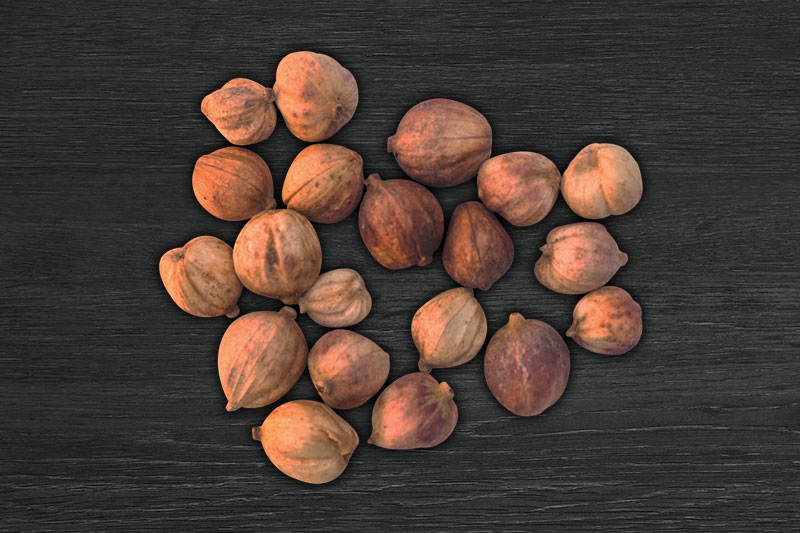
CARDAMOM (LUK KRAWAN, ลูกกระวาน – PRONOUNCED: LÛUK GRÀ-WAAN)
- Strong, spicy aroma with a slightly bitter-sweet taste
- Neutralises odours and is a key ingredient in curry pastes
- Relieves phlegm, aids digestion, eases bloating and indigestion
- Dishes: Massaman Curry, Phanaeng Curry, Spicy Stir-fried Beef, Braised Beef, Phalo (Thai Five-Spice Stew), Khao Mok Gai (Thai-style Chicken Biryani), Noodle Soups

CORIANDER SEEDS (LUK PHAK CHI, ลูกผักชี – PRONOUNCED: LŪK PÀK-CHEĒ)
- Aromatic with a mild, tangy spice. Used in meat marinades and curry pastes
- Enhances appetite and alleviates dizziness
- Dishes: Chu Chee Curry, Phanaeng Curry, Fried Beef, Fried Chicken, Sweet Marinated Pork, Sun-dried Pork

BLACK PEPPER (PHRIK THAI, พริกไทย – PRONOUNCED: PRÎK-TAI)
- Spicy and pungent, neutralises odours, a key ingredient in curry pastes
- Aids digestion, eases bloating, reduces dizziness, helps eliminate excess fat
- Can be dried and ground for sprinkling on soups, noodles, fried rice, stir-fried vegetables, and rice porridge with fish
- Can be used fresh in stir-fried spicy dishes, Kaeng Pa (Jungle Curry), spicy catfish stir-fry, chilli dips, and Khua Kling (Southern Dry Curry)
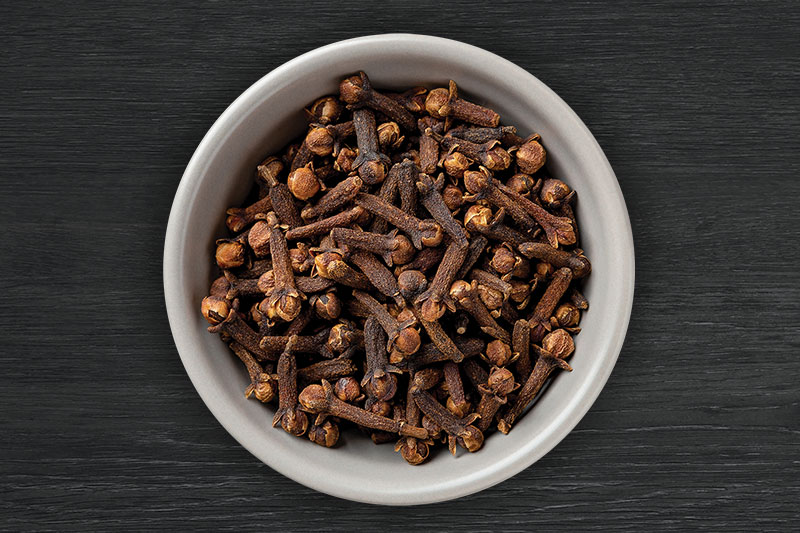
CLOVES (KANPHLU, กานพลู – PRONOUNCED: GAAN-PLUU)
- Aromatic and spicy, used in curry pastes and meat marinades
- Helps relieve bloating, toothaches, and indigestion. Contains calcium and phosphorus, supporting bone health
- Dishes: Massaman Curry, Beef Soup, Phalo (Thai Five-Spice Stew), Khao Mok Gai, Braised Beef, Oxtail Soup, Thai-style Curry, Satay
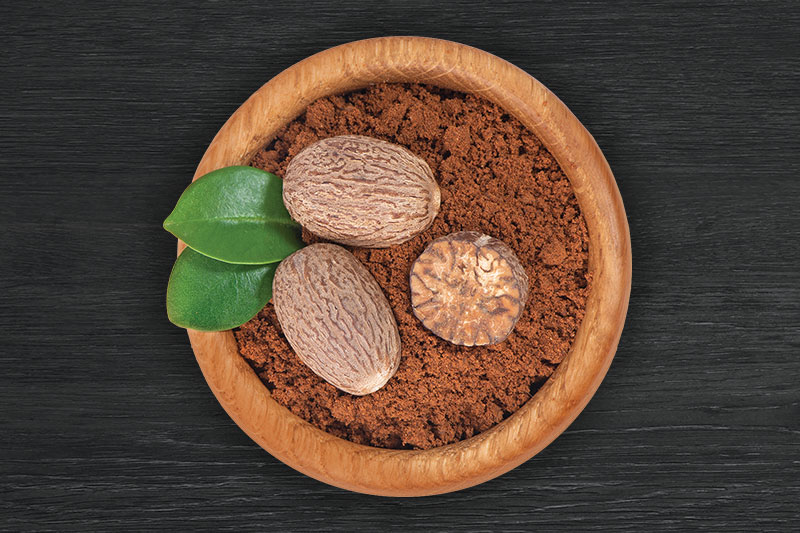
NUTMEG (LUK CHAN/ CHAN THET, ลูกจันทน์/ จันทน์เทศ – PRONOUNCED: LŪK JAN/JAN THĒT)
- Fragrant and neutralises odours. Used in spice blends and curry pastes
- Aids digestion, reduces bloating, and supports urinary tract health
- Dishes: Massaman Curry, Thai-style Coconut Curry, Thai Curry with Roasted Duck, Khao Mok Gai
Herbs
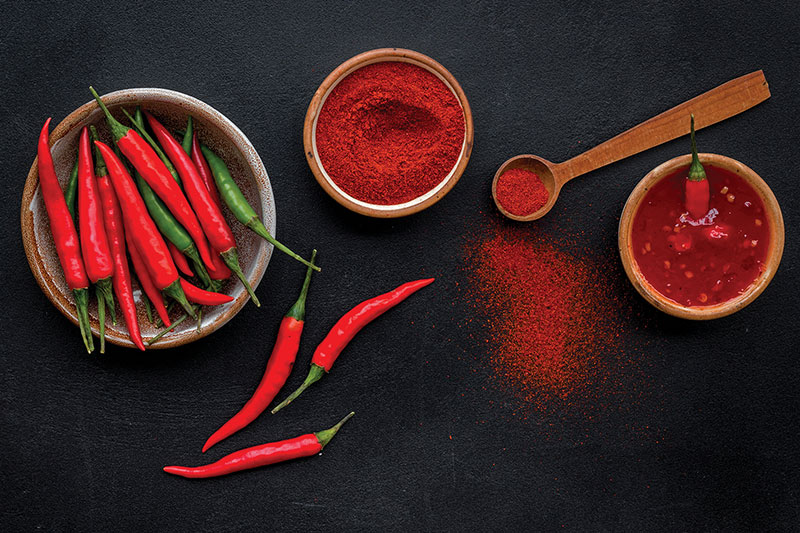
CHILLI PEPPERS (PHRIK, พริก – PRONOUNCED: PRÎK)
- Adds heat and fragrance to most Thai dishes, from soups to stir-frieds
- Boosts metabolism, aids digestion, supports immunity, and is rich in antioxidants
- Dishes: Tom Yum, Som Tam (Green Papaya Salad), Spicy Stir-fries, Green Curry, Red Curry, Massaman Curry, Spicy Thai Salads, Thai Basil Stir-fry, Chilli Dips
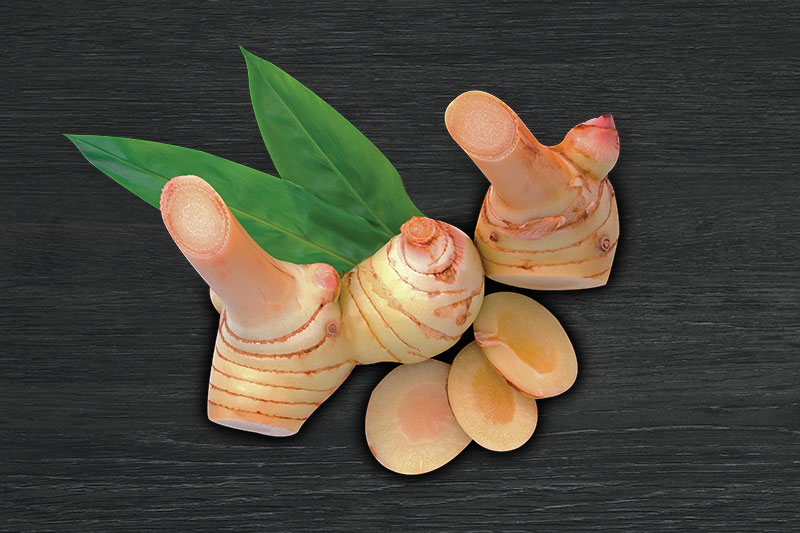
GALANGAL (KHA, ข่า – PRONOUNCED: KHÀA)
- Sharp citrusy aroma with a pungent, spicy flavour. Essential for Thai soups and curries
- Aids digestion, relieves bloating, and has anti-inflammatory properties
- Dishes: Nam Phrik (Chilli Dips), Spicy Salads, Tom Yum, Tom Kha (Coconut Soup with Galangal), Thai Noodle Soups, Rice Soup with Fish, Mieng Kham (Betel Leaf-Mieng Kham (Betel Leaf-Wrapped Bites)
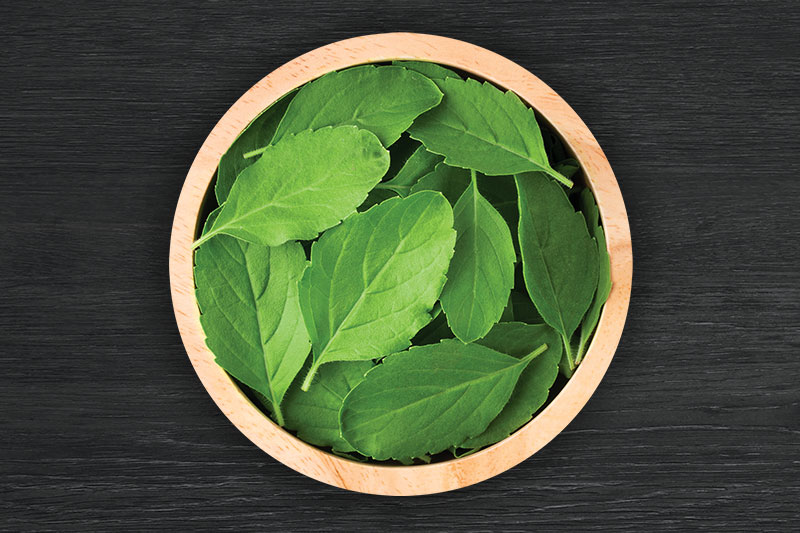
HOLY BASIL (KAPHRAO, กะเพรา – PRONOUNCED: GÀ-PRAO)
- Strong aroma, mellows strong meat odours, enhances stir-fries and curries
- Promotes warmth in the body, reduces inflammation, relieves colds, regulates blood sugar
- Dishes: Phad Kaphrao (Stir-fried Basil with Meat), Phad Khi Mao (Drunken Noodles), Spicy Stir-fries, Kaeng Pa (Jungle Curry), Tom Yum Po Taek (Spicy Seafood Soup), Tom Yum Pla Too (Spicy Mackerel Soup), Clear Soups
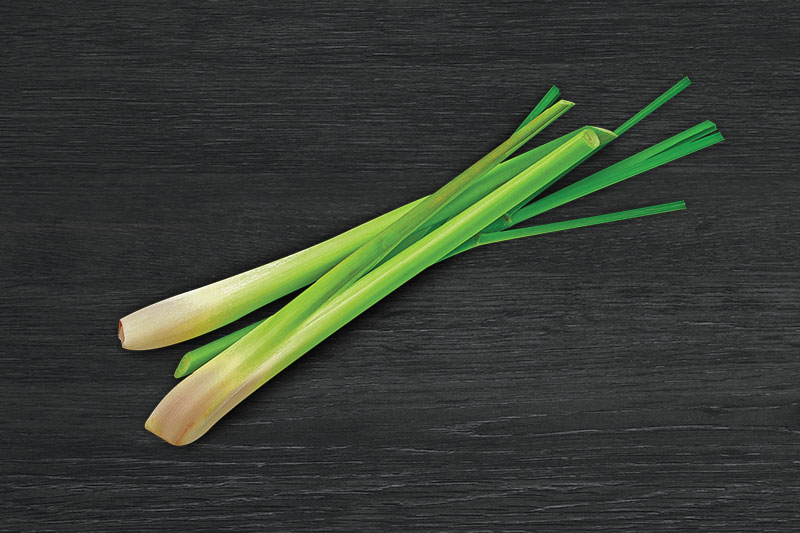
LEMONGRASS (TAKHRAI, ตะไคร้ – PRONOUNCED: DTÀ-KRÁI)
- Aromatic and used in spice blends and curry pastes
- Supports digestion, relieves fatigue, and has calming properties
- Dishes: Nam Phrik, Spicy Salads, Thai-style Shrimp Salad, Tom Yum, Tom Kha, Jungle Curry, Steamed Fish with Lime, Lemongrass Tea
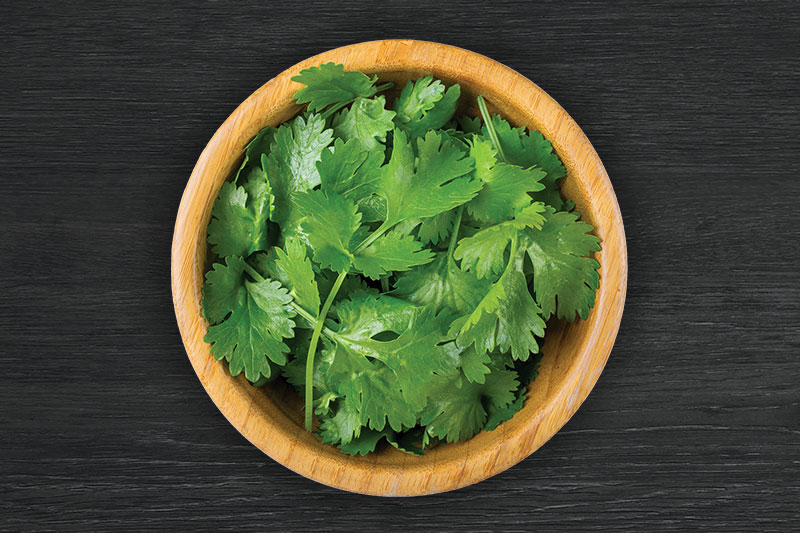
CORIANDER (PHAK CHI, ผักชี – PRONOUNCED: PÀK-CHEĒ)
- Roots: Often pounded with garlic and pepper as a base for stir-fries, soups, and curries
- Aids digestion, supports kidney function, lowers blood pressure, rich in antioxidants
- Dishes: Thai-style Salads, Laab, Spicy Meat Salad, Tom Yum, Garnish for Thai Dips, Sweet Fish Sauce with Neem Leaves
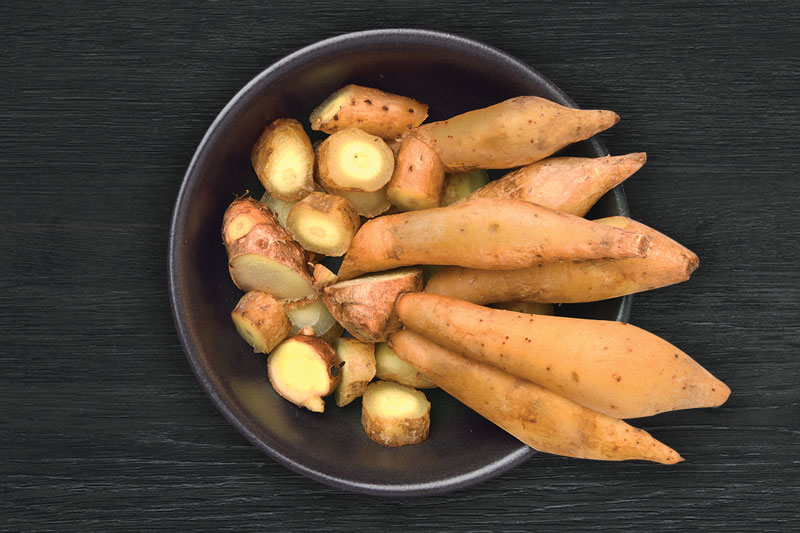
FINGERROOT (KRACHAI, กระชาย – PRONOUNCED: GRÀ-CHAAI)
- Strong aroma with a spicy, peppery flavour, reduces fishy smells
- Reduces dizziness, supports energy levels, alleviates fatigue, strengthens hair
- Dishes: Gaeng Khi Lek (Senna Leaves Curry), Thai Fish Curry, Gaeng Liang (Thai Vegetable Soup), Spicy Stir-fries, Stir-fried Catfish with Curry Paste
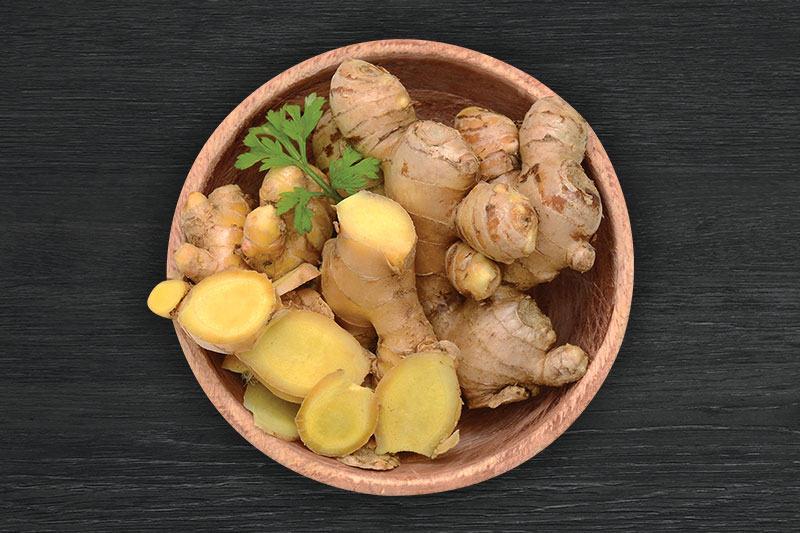
GINGER (KHING, ขิง – PRONOUNCED: KǏNG)
- Fragrant with a spicy kick, removes strong odours
- Relieves bloating, aids digestion, clears phlegm,and alleviates cold symptoms
- Dishes: Stir-fried Chicken with Ginger, Sour Soup, Steamed Fish, Ginger Tea, Chilli Dips, Vegetable Side Dishes, Mieng Kham (Betel Leaf-Wrapped Bites)
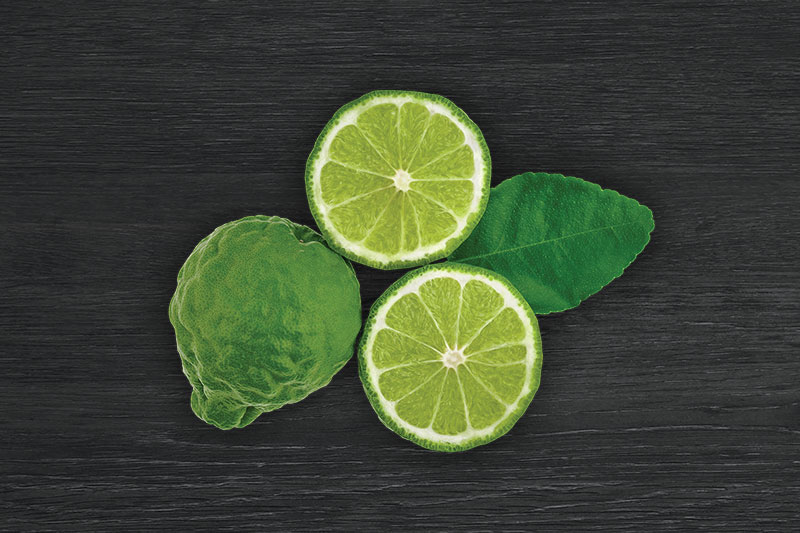
KAFFIR LIME (MAKRUT, มะกรูด – PRONOUNCED: MÁ-KRÙUT)
- Zest of the fruit used for fragrance in curry pastes
- Leaves used to boost aroma of dishes
- Infuses food with a unique citrusy fragrance
- Supports detoxification, promotes relaxation, and aids sleep
- Dishes: Chu Chee Curry (Thai red curry with a creamy coconut sauce), Thot Mun Pla (Thai Fish Cakes), Chilli Dip with Rice Noodles, Red Curry, Green Curry, Thai Coconut Curry, Tom Yum, Deep-fried Kaffir Lime Leaves with Beef or Sun-dried Pork
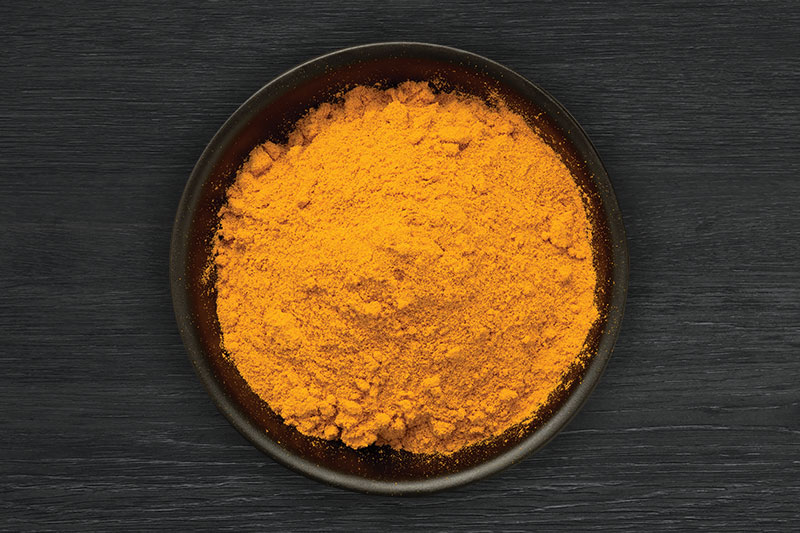
TURMERIC (KHAMIN, ขมิ้น – PRONOUNCED: KÀ-MÎN)
- Adds a vibrant yellow colour and earthy flavour to curries
- Rich in curcumin, anti-inflammatory, supports joint health and immunity
- Dishes: Kaeng Lueang (Southern Thai Yellow Curry), Gai Thot Khamin (Fried Turmeric Chicken)
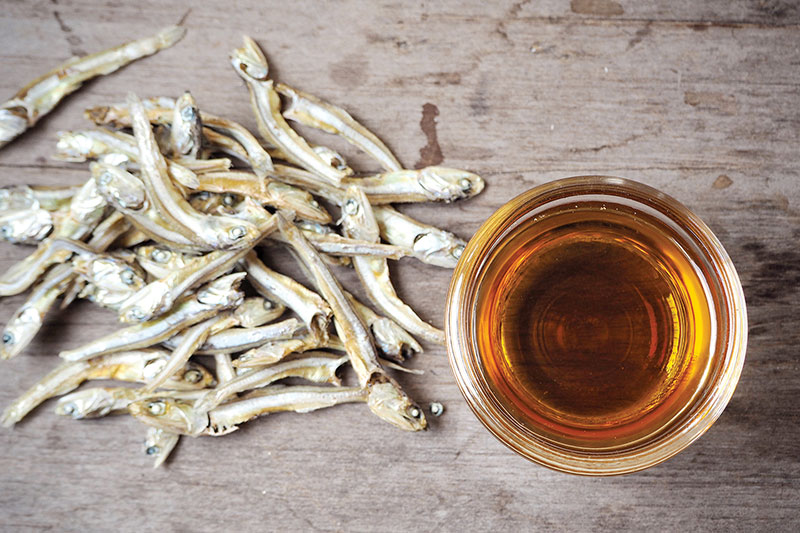
FISH SAUCE (NAM PLA, น้ำปลา – PRONOUNCED: NÁM-BPLAA)
- A staple in Thai cuisine, fish sauce adds depth and umami to dishes like stir-fries, soups, dipping sauces, and marinades
- Rich in protein and essential amino acids, it enhances flavour naturally with minimal added sodium
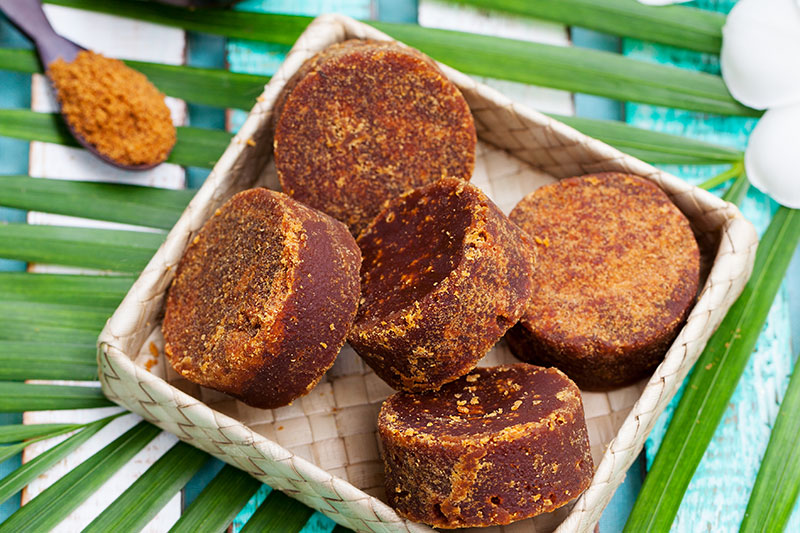
PALM SUGAR (NAM TAN MAPHRAO, น้ำตาลมะพร้าว – PRONOUNCED: NÁM-TĀAN MÁ-PRÁAO)
- Commonly used in Thai desserts, curries, and sauces, palm sugar balances flavours with its subtle caramel-like sweetness
- A more natural sweetener with a lower glycaemic index than refined sugar, providing sustained energy release
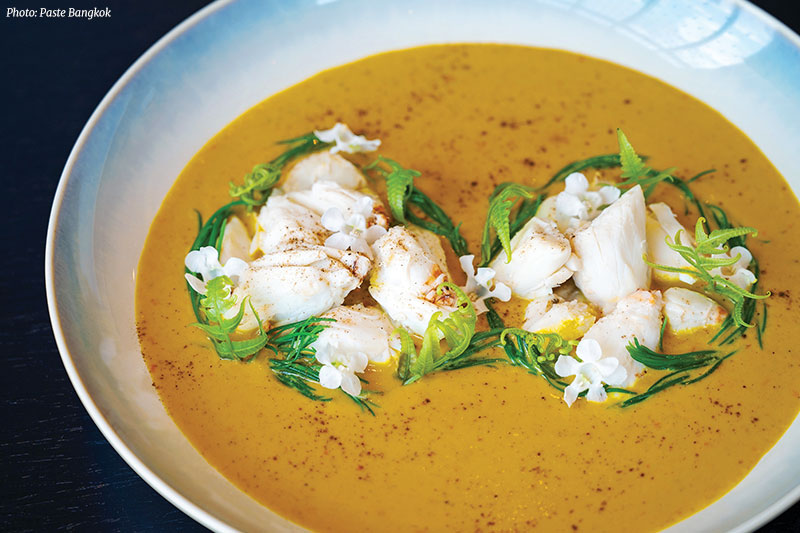
Thai Spice on the Global Stage
Thai herbs and spices have travelled far and wide, shaping various cuisines in exciting ways. Restaurants, chefs, and foodies worldwide have embraced Thai spices, incorporating them into fusion dishes and gourmet experiences. High-end restaurants have adopted Thai basil, lemongrass, and galangal in their creations, while supermarkets from Sweden to South Korea now stock Thai curry pastes, fish sauce, and tamarind as staples.
One such culinary innovator is Paste Bangkok, where traditional Thai flavours are reimagined in a sophisticated way. Their Smoky Southern Yellow Curry with Blue Crab & Thai Samphire elevates a classic yellow curry by infusing it with smoky notes from grilled coconut. The addition of Thai samphire – a coastal herb – creates a briny contrast that enhances the sweetness of the crab, while the yellow curry provides a deep, complex heat. This innovative dish reflects how Thai cuisine continues to evolve while preserving its traditional essence, proving that even in sophisticated dining settings, the bold flavours of Thai spices continue to thrive.
Thai cooking schools in Europe, the US and Australia further promote the use of authentic Thai ingredients, ensuring the preservation of traditional flavours even outside Thailand. The growing demand for plant-based food has also led to an increased appreciation for Thai spices, which add complexity and depth to vegetarian and vegan dishes.
Today, classic Thai dishes like Massaman, Tom Yum Goong, Khao Soi, and Phanaeng are cherished worldwide and Thai spice pastes and pre-made curry sauces are readily available to help home cooks recreate authentic dishes.
Thai spices are also making their way into unexpected culinary spaces, including cocktail mixology, artisanal chocolates, and gourmet condiments. Lemongrass and kaffir lime are now popular infusions in craft gin and tonic, while chilli and tamarind are being used in innovative dessert creations. This evolution demonstrates how Thai ingredients continue to inspire culinary creativity across industries.
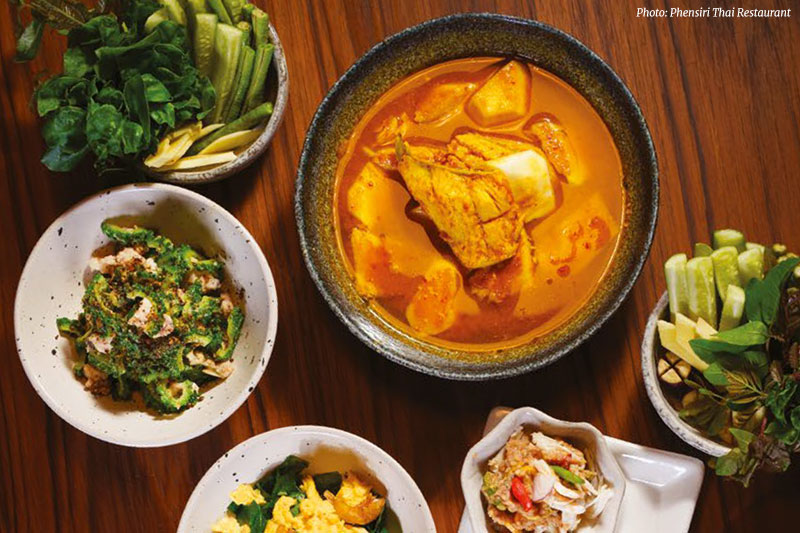
Organic, Sustainable, and Potent
As Thai food gains global popularity, the responsibility to ensure sustainable and ethical sourcing also grows. Organic farming in Thailand helps maintain the purity and potency of these spices, while fair trade practices support local farmers. Eco-conscious brands are now offering responsibly sourced Thai spices, ensuring high quality while preserving Thailand’s agricultural heritage.
In response to rising environmental concerns, Thai farmers are also adopting regenerative agriculture techniques to ensure long-term soil health and biodiversity. These efforts not only improve spice quality but also align with the growing consumer preference for sustainable and ethically sourced food products.
At Phensiri Thai Restaurant in Koh Samui, sustainability is a key principle in crafting their dishes. The restaurant sources only fresh produce, the catch of the day, and local Samui ingredients. A prime example is their Gaeng Som Pla Yod Maphrao, a Southern Thai sour curry that embodies both flavour and sustainability. Made with turmeric, tamarind, and lemongrass, the curry’s vibrant, tangy broth complements locally sourced fish. Served with a side of pickled vegetables, the dish is enhanced by young coconut shoots, adding sweetness and a crisp texture. Beyond its delightful balance of sour, spicy, and slightly sweet flavours, this dish is a reflection of the restaurant’s commitment
to sustainable dining. With its anti-inflammatory ingredients like turmeric and tamarind, Gaeng Som offers both a nourishing meal and a step towards a more eco-conscious food future.

A Taste of Thailand, Anywhere in the World
Thai spices and herbs have travelled from local markets to gourmet kitchens worldwide, bringing the essence of Thailand to international cuisine. From the heat of chillies, the tang of tamarind, and the depth of fish sauce, these ingredients continue to define the soul of Thai food. Their distinctive flavours, coupled with impressive health benefits, make them invaluable in any kitchen. As Thailand continues to share its culinary treasures, these spices will remain ambassadors of its rich cultural and gastronomic legacy.
Across Thailand, restaurants are embracing this culinary heritage while refining traditional flavours into contemporary expressions. At Sa-Nga in Centara Reserve Samui, Thai flavours are reimagined with a modern touch, creating dishes that blend tradition with innovation. A prime example is the Tom Yum Cappuccino with tiger prawn and young coconut, an elevated take on Thailand’s most iconic soup. This dish transforms the bold, citrusy spice of tom yum into a velvety, frothy cappuccino-like texture, offering a smooth yet intensely tasty experience. The base is a deeply aromatic broth infused with lemongrass, galangal, kaffir lime leaves, and roasted chilli paste, balancing heat, acidity, and umami. The plump tiger prawn, delicately poached, adds a natural sweetness, while tender slivers of young coconut introduce a subtle, creamy contrast. Served in an elegant cup, this dish highlights Sa-Nga’s creative approach – honouring classic Thai flavours while presenting them in a refined, unexpected way. It’s a must-try for those looking to experience Thai cuisine with a modern, luxurious twist.

While Sa-Nga plays with texture and presentation, 22 Steps Craft House at Hotel Indigo Bangkok Wireless Road stays closer to the roots of Northern Thai cuisine, elevating Khao Soi Gai with a delicate yet deeply layered execution. The bone-in chicken is gently braised in a fragrant coconut curry, infused with turmeric, galangal, and a medley of warm spices that deepen its complexity. The broth, velvety and aromatic, clings to the soft egg noodles beneath, while a crisp nest of golden noodles lends crunchy contrast. A side of pickled mustard greens, shallots, lime, and roasted chilli oil allows for layers of acidity and heat to be adjusted to taste. Every element is carefully considered, creating a dish that feels both deeply familiar and thoughtfully composed – a restrained yet expressive take on one of Northern Thailand’s most iconic flavours.
It’s dishes like these, whether honouring tradition or pushing creative boundaries, that ensure Thai cuisine continues to evolve while staying rooted in its rich culinary heritage. As Thai food cements its place as a global favourite, its legacy of bold flavours, fragrant spices, and refined techniques will continue to inspire new generations of chefs, home cooks, and food lovers alike.
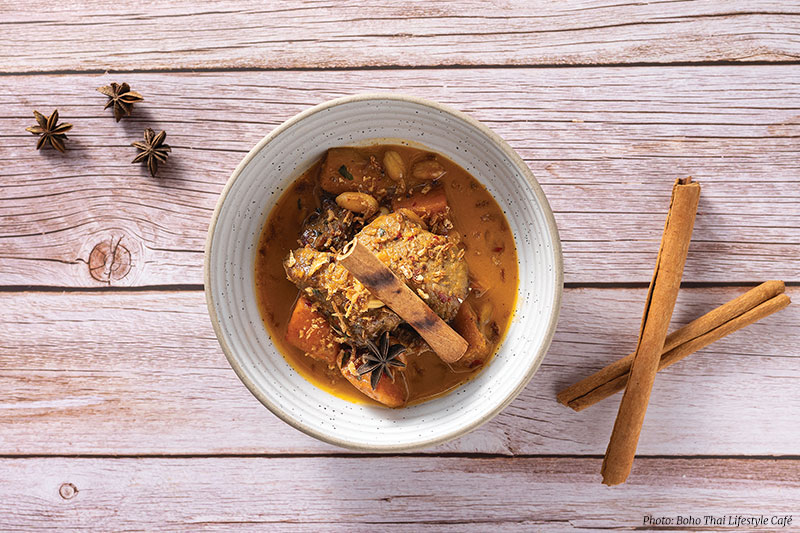
The Perfect Balance of Thai Flavours
International trade has transformed Thai food culture, bringing foreign spices that have been seamlessly integrated into Thai kitchens. Thai chefs have masterfully adapted these ingredients to suit local tastes, creating a cuisine celebrated for its harmonious balance of flavours. From the Ayutthaya period to the present day, Thai food remains a testament to the country’s culinary expertise. Its signature blend of spicy, sour, sweet, creamy, and salty flavours has captivated taste buds worldwide, making Thai cuisine one of the most beloved in the world.
This interplay of flavours is constantly reinterpreted, even in unexpected ways. At Boho Thai Lifestyle Café in Kimpton Kitalay Samui, the Massaman Beef reflects a deep appreciation for Thai culinary heritage while embracing a modern approach. A cherished recipe passed down through generations, this dish is crafted with slow-braised beef, simmered in a rich and aromatic Massaman curry infused with a carefully selected blend of spices unique to Boho Thai Lifestyle. The creamy coconut base, complemented by toasted peanuts, hearty potatoes, and sweet carrots, creates layers of warmth and complexity. Every bite embodies the comforting essence of traditional Thai cooking, enhanced by the chef’s personal touch. More than just a meal, this dish is a reflection of Thailand’s ability to preserve its culinary roots while continuously evolving.
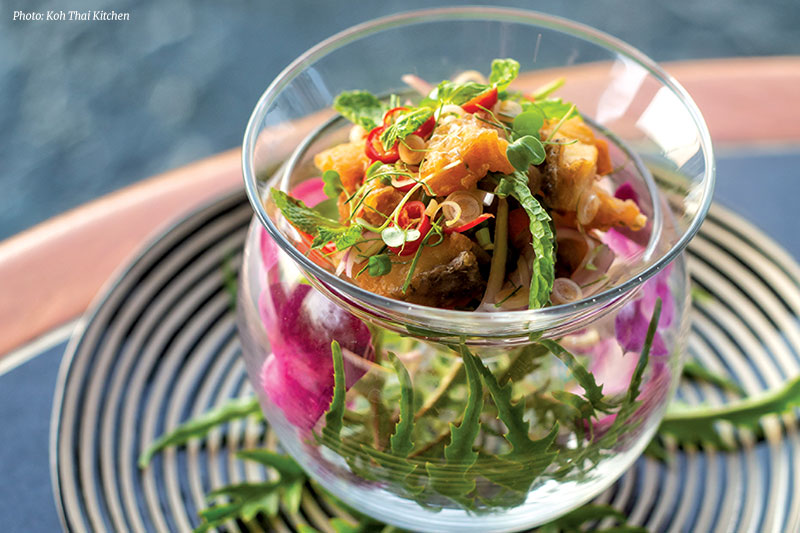
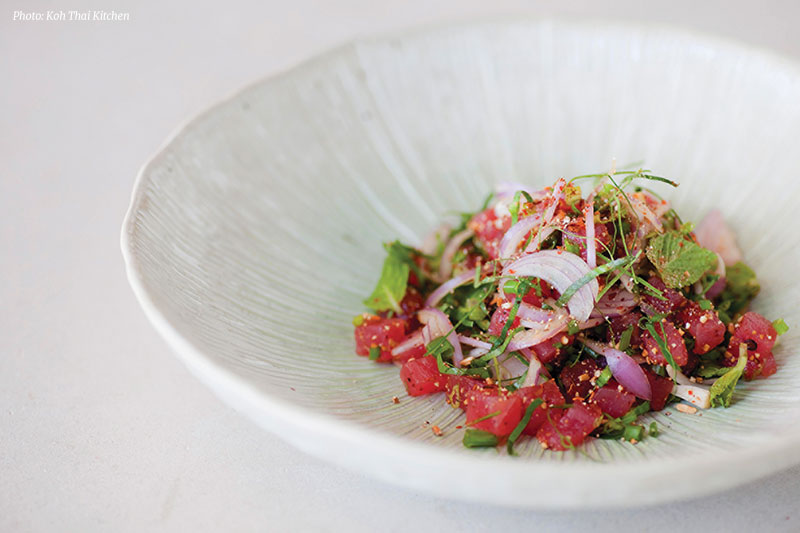
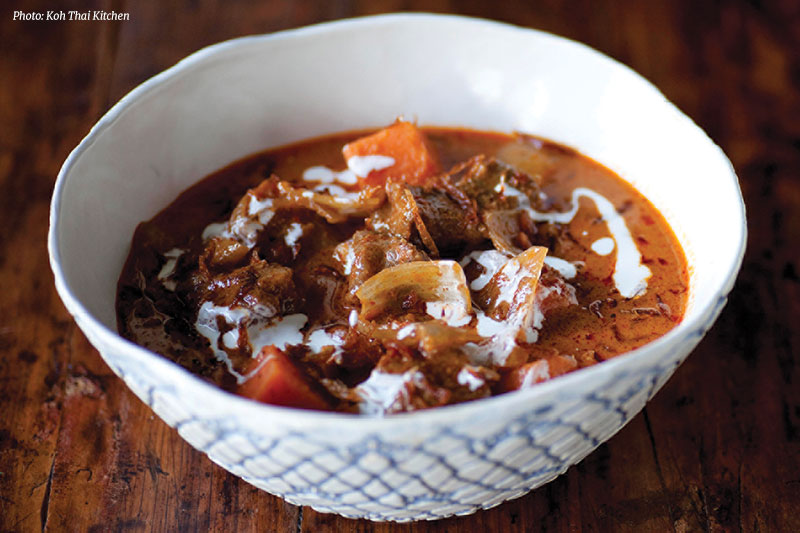
Koh Thai Kitchen at Four Seasons Resort Koh Samui, set on a palm-fringed hilltop with sweeping views of the Gulf of Thailand, offers a setting as unforgettable as its cuisine. Under the guidance of Chef de Cuisine Sumalee Khunpet, fondly known as Chef Jeab, Koh Thai Kitchen is dedicated to authentic Southern Thai flavours, showcasing the region’s vibrant ingredients and time-honoured techniques.
Chef Jeab’s menu brings together bold, deeply rooted flavours with a touch of contemporary finesse. Larb Tuna, a twist on the classic Thai laab, features fresh tuna marinated with Thai herbs, cracked rice, and chili powder, delivering layers of heat, crunch, and citrusy zest. The Gaeng Massaman Nua, a slow-cooked Wagyu beef cheek bathed in a fragrant, cardamom- laced Massaman curry, is a shining example of the rich, slow-simmered stews of the South. Meanwhile, the signature Plaa Pla, a crispy sea bass salad with lemongrass, shallots, and fresh herbs, captures the bright, herbal notes that define the coastal cuisine of Thailand.
Beyond its expertly curated menu, Koh Thai Kitchen’s themed dining experiences offer deeper insight into the region’s culinary traditions. The Curry Nights celebrate the spectrum of Thai curries, while Tam Rab Thai, a cultural dining event, brings together the best of southern Thai flavours, music, and traditions in an immersive gastronomic journey.
At Koh Thai Kitchen, each dish is a tribute to Thailand’s rich culinary heritage, served with warmth and authenticity. It is a place where the soul of Southern Thai cuisine shines – where time- honoured recipes meet the freshest island ingredients, and where every meal is both a discovery and a celebration of Thailand’s gastronomic roots.
As Thai cuisine continues to evolve, its timeless essence endures – an intricate balance of flavours and aromas refined over centuries that captivates both chefs and diners. The richness of Thai culinary heritage, with its bold, aromatic and spicy profiles, remains a true reflection of the country’s cultural vibrancy. For those seeking an authentic taste of Thailand, Fah Thai serves as an essential guide to restaurants where these traditional flavours are preserved and celebrated.
